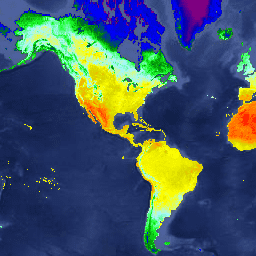Page Summary
-
This dataset, which provides monthly daytime land surface temperature data at approximately 5km resolution, has been superseded by a newer version.
-
The dataset covers the period from March 2001 to June 2015 and was produced by the Oxford Malaria Atlas Project.
-
It is derived from MODIS land surface temperature data that has been gap-filled to account for missing information like cloud cover.
-
The dataset includes bands for the mean temperature in °C and the proportion of the pixel that is comprised of raw data.

- Dataset Availability
- 2001-03-01T00:00:00Z–2015-06-01T00:00:00Z
- Dataset Provider
- Oxford Malaria Atlas Project
- Cadence
- 1 Month
- Tags
Description
The underlying dataset for this daytime product is MODIS land surface temperature data (MOD11A2), which was gap-filled using the approach outlined in Weiss et al. (2014) to eliminate missing data caused by factors such as cloud cover. Gap-free outputs were then aggregated temporally and spatially to produce the monthly ≈5km product.
This dataset was produced by Harry Gibson and Daniel Weiss of the Malaria Atlas Project (Big Data Institute, University of Oxford, United Kingdom, https://malariaatlas.org/).
Bands
Pixel Size
5000 meters
Bands
| Name | Units | Min | Max | Pixel Size | Description |
|---|---|---|---|---|---|
Mean |
°C | -74.03* | 63.87* | meters | The mean value of daytime land surface temperature for each aggregated pixel. |
FilledProportion |
% | 0* | 100* | meters | A quality control band that indicates the percentage of each resulting pixel that was comprised of raw data (as opposed to gap-filled estimates). |
Terms of Use
Terms of Use
Citations
Weiss, D.J., P.M. Atkinson, S. Bhatt, B. Mappin, S.I. Hay & P.W. Gething (2014) An effective approach for gap-filling continental scale remotely sensed time-series. ISPRS Journal of Photogrammetry and Remote Sensing, 98, 106-118.
Explore with Earth Engine
Code Editor (JavaScript)
var dataset = ee.ImageCollection('Oxford/MAP/LST_Day_5km_Monthly') .filter(ee.Filter.date('2015-01-01', '2015-12-31')); var daytimeLandSurfaceTemp = dataset.select('Mean'); var visParams = { min: -20.0, max: 50.0, palette: [ '800080', '0000ab', '0000ff', '008000', '19ff2b', 'a8f7ff', 'ffff00', 'd6d600', 'ffa500', 'ff6b01', 'ff0000' ], }; Map.setCenter(-88.6, 26.4, 1); Map.addLayer( daytimeLandSurfaceTemp, visParams, 'Daytime Land Surface Temperature');